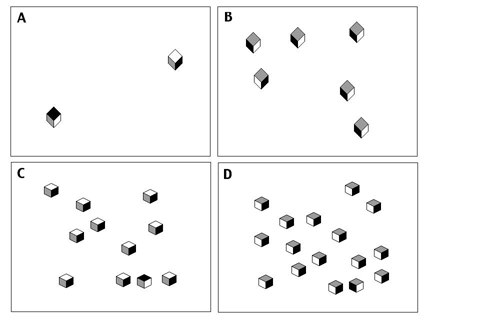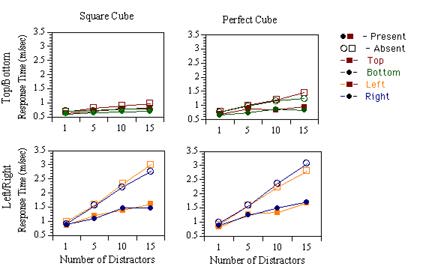
Stephen F. Austin State University
Presented at the South Western Psychological Conference, 2000
Return to Scharff Research Interests page.
Traditionally, visual searches have suggested the existence of two types of visual processing: parallel and serial. Parallel, or preattentive, processing is the search process that occurs when the target object differs from distractors by one basic feature. Thist ype of processing is rapid, since the target object seems to "popout" of the visual display and is easily spotted. Serial is slower because the target object differs from the distractors by multiple features, such as both size and color. This type of search requires the subject to attend to each object in the visual display until the target is located, therefore slowing the response time (Treisman & Sato, 1990)
The current experiment attempted to resolve some differences that appeared between two similar studies, Enns and Rensink (1990) and Riggins and Scharff (1997). Enns and Rensink found that target cubes with top or bottom lighting were preattentively processed. In addition to some other manipulations, Riggins and Scharff used left and right lighting conditions so they could manipulate shadows in the background environment to see if they would enhance the effect of implied lighting. Surprisingly, the cubes were not processed preattentively. Results of control experiments indicated that, with extra practice, some participants showed preattentive processing with the left/right lighting, but all control subjects showed strong preattentive processing with top/bottom lighting. Perhaps the differences between Riggins and Scharff's (1997) conclusions and Enns and Rensink's (1990) conclusions were a result of the two different types of cubes used in the experiments. While Enns and Rensink's cubes were pentagons with vertices that divided the figure into three equal areas that represented the top and two visible sides ("perfectcubes"), Riggins and Scharff used a cube that showed a square-shaped top and two smaller sides ("square cubes"). Because the sides of Riggins and Scharff's cubes had smaller surface areas than the top area, this could explain why their participants showed more serial processing with the left/right lighting than with the top/bottom lighting. Thus, in the current experiment, both "perfect" and"square" cubes were used, with implied lighting from all four directions (top, bottom, left, right).
Design: The experiment used a forced-choice method, in which the participant pressed a specific key if the target was Present or Absent. The within-participants design consisted of 2 (type of cube) X 4 (display density/number of distractors) X 2 (target presence) X 4 (lighting directions). Trials were separated by cube type (perfect cube or square cube) into two stand-alone sets oftrials, the order of which was counter balanced across subjects.Within each of these sets, trials were blocked by implied lighting direction of the target (top, bottom, left, or right), the order of which was counterbalanced using a Latin Square technique. Thus, there were four possible lighting-direction block orders for each cube-type set of trials. Finally, within each lighting- direction block oftrials, the variables of target presence (presence or absence) and display density (1, 5, 10, or 15 distractors) were randomized. Since there were ten trials for each condition, there was a total of 320 trials per cube-type set, and a total of 640 trials overall. To introduce each block, there were four practice trials to help the participants understand the search task.
Stimuli: The stimuli were created in MATLAB also using Psychophysics Toolbox (Brainard, 1997). All cubes had three visible sides, which were shaded to imply lighting from above (top was white), below (top was black), left or right (the respective side was white). The remaining sides were shaded so that one was gray (theleft side in the top/bottom conditions and the top in the left/right lighting conditions), and the final side was either black or white, depending upon what color had not yet been used. See Figure 1 for examples of the different cube shapes with varying numbers of distractors and implied lighting directions.

Figure 1: Sample stimuli for current experiment. A) Square cubes, top lighting, 1 distractor. B)Square cubes, left lighting, 5 distractors. C) Perfect cubes, bottom lighting, 10 distractors. D) Perfect cubes, right lighting, 15 distractors.
Procedure: The participants ran in groups of four to six. All participants had their own computer, and used a chin rest, which kept their eyes approximately 51 cm from the computer screen. Participants were to indicate the presence or absence of the target stimuli by pressing one of two keys on the keyboard. The response keys were counterbalanced across groups so that one half of the participants indicated target presence with a P and target absence with a Q, while the reverse was true for the other half of the participants. Participants were encouraged to answer as quickly, but as accurately as possible. The experimenter remained in the room to observe and answer questions if they arose. Each block of trials had an instruction page and four practice trials to help the participantget acquainted with the target. When they were ready, the participants proceeded with the 80 experimental trials for each block. Upon the completion of both sets, subjects were debriefed about the nature of the experiment and reminded not to discuss the experiment with anyone outside of the class.
After the participants ran the experiment, their data were sorted by condition, and error rates were calculated. For the 32 participants with low error rates, the medians of all the correct trials were calculated per subject, per condition. A four-way analysis of variance (ANOVA) of the medians showed significant main effects as well as several significant interactions. See Figure 2 forthe plot of the means for all conditions.
There was a significant main effect for lighting direction (F(3,93)=103, p<.01), such that the top/bottom conditions were processed more rapidly than the left/right conditions. Post hoc analyses showed no significant difference between top and bottom lighting or between left and right lighting. There was no significant main effect for cube shape.
Not surprisingly as the number of distractors increased, there was a significant increase in search time (F(3, 93)=195.2, p<.01). Also, target absent trials were significantly slower than target present trials (F(1, 31)=161.8, p<.01). However, these main effects were strongly modified by interactions between the variables. The number of distractors showed a significant interaction with target presence (F(3, 93)=117.1, p<.01) so that absent trials showed a stronger effect of number of distractors. Further, a significant three-way interaction between lighting direction, numberof distractors, and target presence (F(9,279)=31.8, p<.01) suggests that this trend only occurs for the left/right lighting and not the top/bottom lighting. More specifically, this suggests that the top/bottom conditions are processed preattentively while the left/right conditions are not.
By looking at the graph of the four-way interaction (Figure 2),one can see that the slopes of the lines for top/bottom lighting directions are flat across number of distractors, indicating a preattentive search style, while the slopes are steeper for left/right lighting directions. Finally, there was a significant four-way interaction (F(9, 279)=2.1, p<.05); lighting direction significantly interacted with cube-shape (F(3, 93)=4.2, p<.01) such that targets with bottom lighting were seen faster than top lighting for the square cubes, but not for the perfect cubes. There was no difference in search time using the left/right targets for the different cube types.

Figure 2 - Means for all conditions. Slopes of the lines or the top/bottom lighting directions are flat across number of distractors, indicating a preattentive search style, while the slopes are steeper for left/right lighting directions, indicating a serial search.